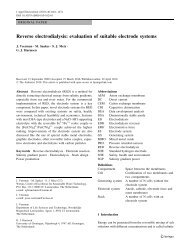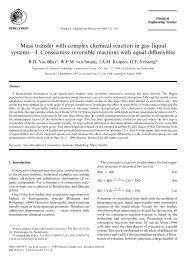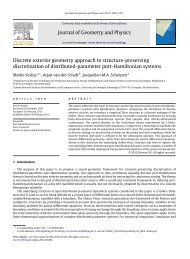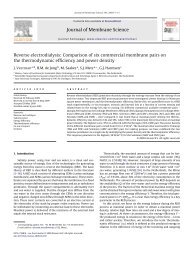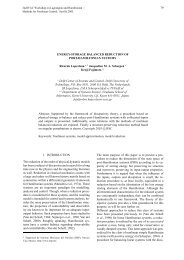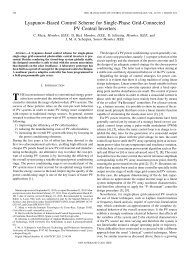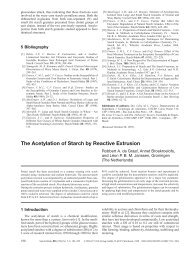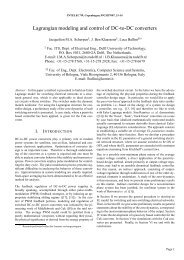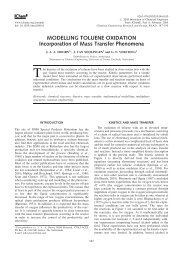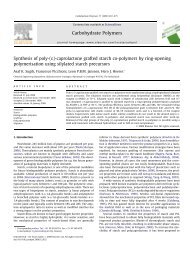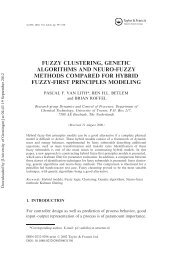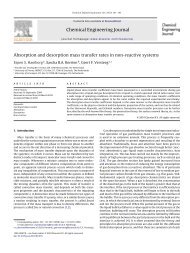Equilibria and kinetics for reactive extraction of lactic acid ... - ITM
Equilibria and kinetics for reactive extraction of lactic acid ... - ITM
Equilibria and kinetics for reactive extraction of lactic acid ... - ITM
You also want an ePaper? Increase the reach of your titles
YUMPU automatically turns print PDFs into web optimized ePapers that Google loves.
Reactive <strong>extraction</strong> <strong>of</strong> <strong>lactic</strong> <strong>acid</strong>processes, <strong>lactic</strong> <strong>acid</strong> has been recovered from thefermentation broth by precipitation <strong>of</strong> calcium lactatewith calcium hydroxide. In this, the separation <strong>and</strong>®nal puri®cation stages account <strong>for</strong> up to 50% <strong>of</strong> theproduction costs. 4,5 Thus, this method <strong>of</strong> recovery isexpensive 6,7 <strong>and</strong> unfriendly to the environment as itconsumes lime <strong>and</strong> sulfuric <strong>acid</strong> <strong>and</strong> also produces alarge quantity <strong>of</strong> calcium sulfate sludge as solid waste. 6Allowing accumulation <strong>of</strong> <strong>lactic</strong> <strong>acid</strong> product infermentation broth inhibits further product <strong>for</strong>mation.Reactor productivities are low <strong>and</strong> the products areobtained in a dilute <strong>for</strong>m. The effects <strong>of</strong> end productinhibition can be reduced by in-situ removal <strong>of</strong> <strong>lactic</strong><strong>acid</strong> from fermentation broth by several methods.A number <strong>of</strong> processes <strong>for</strong> <strong>lactic</strong> <strong>acid</strong> recovery fromfermentation broth without precipitation have beenstudied: solvent <strong>extraction</strong>, 8±15 membrane bioreactor,16,17 liquid surfactant membrane <strong>extraction</strong>, 18,19adsorption, 20 direct distillation, 21 electrodialysis, 22±24chromatographic methods, 15 ultra®ltration, 15 reverseosmosis, 15,25 drying, 15 etc.Reactive <strong>extraction</strong> with a speci®ed extractant givinga higher distribution coef®cient has been proposed as apromising technique <strong>for</strong> the recovery <strong>of</strong> carboxylic <strong>and</strong>hydroxycarboxylic <strong>acid</strong>s. 8,26 Solvent <strong>extraction</strong> withtertiary amines has been widely used to recover/fractionate metals such as uranium, iron, cobalt, etcfrom aqueous solutions. 27 Long chain tertiary amineswere used commercially <strong>for</strong> recovery <strong>of</strong> ethanoic <strong>acid</strong>from dilute aqueous streams. 14,28 Tertiary amines<strong>of</strong>fer advantages over other extractants, on thegrounds <strong>of</strong> lower cost <strong>and</strong> generally higher equilibriumdistribution coef®cients (K D). 29 Tertiary amines werefound to be effective <strong>for</strong> extracting <strong>lactic</strong> <strong>acid</strong>, <strong>and</strong>alcohols were among the best diluents, with theadditional advantage that a <strong>lactic</strong> <strong>acid</strong> ester could beproduced after the <strong>extraction</strong> process was completed.30,31 Alamine 336 (mixture <strong>of</strong> C 8,C 9<strong>and</strong> C 10tertiary amines) yields a good combination <strong>of</strong> high K D,low solubility in water <strong>and</strong> good regenerability.The design <strong>of</strong> an amine <strong>extraction</strong> process requires(i) equilibrium <strong>and</strong> (ii) kinetic data <strong>for</strong> the <strong>acid</strong>±amine(solvent) system used. However, little in<strong>for</strong>mation onthe equilibria <strong>and</strong> no in<strong>for</strong>mation pertaining to <strong>kinetics</strong>are available. In view <strong>of</strong> this it was thought desirable toobtain the equilibria <strong>and</strong> <strong>kinetics</strong> <strong>for</strong> the <strong>extraction</strong> <strong>of</strong><strong>lactic</strong> <strong>acid</strong> by Alamine 336 (a tertiary amine, withaliphatic chains <strong>of</strong> 8±10 carbon groups) dissolved indecanol, as diluent.range (0.005±1.5kmol m 3 ) <strong>of</strong> <strong>lactic</strong> <strong>acid</strong> concentrationwas used.The <strong>reactive</strong> component was Alamine 336 (straightchain tertiary amine containing C 8±C 10alkyl groups(Henkel Corp, USA)) with decanol as diluent.Alamine was used as supplied.2.2 Methods2.2.1 <strong>Equilibria</strong>All experiments were carried out at room temperature<strong>of</strong> 25°C. Known volumes <strong>of</strong> aqueous (different concentrations<strong>of</strong> <strong>lactic</strong> <strong>acid</strong>) <strong>and</strong> organic phases (30cm 3each) (both pure decanol <strong>and</strong> decanol containingdifferent concentrations <strong>of</strong> Alamine 336) <strong>of</strong> knownconcentrations were equilibrated in a temperaturecontrolledshaker bath <strong>for</strong> 24h. The two phases wereallowed to settle <strong>for</strong> at least 30min, which wassuf®cient time <strong>for</strong> a complete phase separation. 32 Todetermine the concentration <strong>of</strong> <strong>lactic</strong> <strong>acid</strong>, the aqueousphase was titrated with NaOH using phenolphthaleinas indicator. The <strong>acid</strong> concentrations in the organicphase were calculated by mass balance.2.2.2 KineticsA stirred cell (Fig 1) <strong>of</strong> 0.07m in diameter <strong>and</strong> 0.1mheight, with a ¯at bottom was used <strong>for</strong> the <strong>kinetics</strong>tudies. 33 A 100cm 3 sample <strong>of</strong> an aqueous solution <strong>of</strong><strong>lactic</strong> <strong>acid</strong> <strong>of</strong> known concentration was ®rst placed inthe vessel. The position <strong>of</strong> the four-blade paddle(0.058m in diameter <strong>and</strong> 0.01m in width) doublestirrer was adjusted to 0.01m below <strong>and</strong> above theinterface. A ®xed volume (100cm 3 ) <strong>of</strong> the organicextractant mixture was then added, <strong>and</strong> the mixturewas stirred. Using <strong>acid</strong>±base titration with NaOH <strong>and</strong>phenolphthalein as indicator, the <strong>acid</strong> concentration inthe aqueous phase was determined periodically. Theconcentration <strong>of</strong> <strong>lactic</strong> <strong>acid</strong> in the organic phase wasdetermined by mass balance.The reproducibility was checked by carrying out2 MATERIALS AND METHODS2.1 MaterialsAll the chemicals used (<strong>lactic</strong> <strong>acid</strong>, decanol, sodiumhydroxide) were <strong>of</strong> reagent grade <strong>and</strong> were usedwithout pretreatment. All solutions <strong>of</strong> <strong>lactic</strong> <strong>acid</strong> wereprepared by dissolving <strong>lactic</strong> <strong>acid</strong> <strong>of</strong> analytical purity indistilled water. In practical situations <strong>of</strong> <strong>acid</strong> recoveryfrom fermentation broths, the <strong>acid</strong> concentrations arenot expected to be high. Hence, a low concentrationFigure 1. Stirred cell used <strong>for</strong> kinetic study.J Chem Technol Biotechnol 77:1068±1075 (online: 2002) 1069



